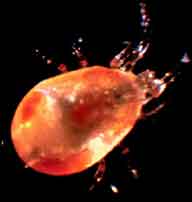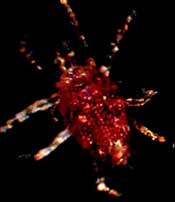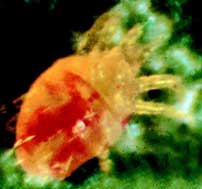Early summer scouting and management options for mites in apples
Editor’s note: This article is from the archives of the MSU Crop Advisory Team Alerts. Check the label of any pesticide referenced to ensure your use is included.
Mid-June is a good time of the season to be scouting for European red mite and two-spotted spider mites in apple orchards. Initial sprays (or other controls) for key early season pests, like codling moth, have already occurred such that the impact of those actions on mite populations will be readily evident. We recommend monitoring mites using a 100-leaf sample, 50 percent spur leaves and 50 percent shoot leaves, and counting the numbers of each pest species along with key predator mite species. The three most important predaceous mites are Amblyseius fallacis (Phytoseiidae), Agistemus fleschneri (Stigmaeidae), and Zetzellia mali (Stigmaeidae). Predaceous mites are smaller than adult European red mite, but they can be seen with a hand lens and typically move very quickly across leaf surfaces. Control measures may be warranted for mature, healthy trees based on the following thresholds:
- 2-3 mites per leaf from petal fall to mid-June
- 5-7 mites per leaf from mid-June through July
- 10-15 mites per leaf in August
The presence of predaceous mites (less than one per leaf) and heavy rainfall, which can remove mites from the canopy, may justify postponing a treatment. Continued weekly sampling with the above suggested 100-leaf sample, is the primary means to assure that mite pest populations remain in check, while potentially saving the application of an unnecessary spray.
Apollo, Savey and Agri-Mek all provide extended control of European red mites, ranging from 10 weeks to full season depending on mite pressure, tree vegetative growth and predator mite populations. Savey and Apollo work primarily as ovicides, but are now labeled for in-season use with their respective 28-day and 45-day pre-harvest intervals. Agri-Mek is most effective when applied between petal fall and first cover (14 days past petal fall) with the addition of one gallon of paraffinic spray oil per acre. Zeal and Envidor are excellent mid-range residual materials (8-12 weeks) that have flexibility for early or late season application. They are relatively safe on predatory mites, but because of their unique mode-of-action, they are somewhat slower acting than contact miticides.
Nexter, Portal, Kanemite and Acramite are good contact miticides, which when used in early summer can provide six to eight weeks of control, or later as a “clean up” application if early season products have lost control of mites. Vendex provides good control during warm weather. Vydate will kill some mites, but is very toxic to predators and causes fruit drop if used within 30 days after petal fall.



Left, Amblyseius fallacis. Middle, Agistemus fleschneri. Right, Zetzellia mali.
Photos are from A Pocket Guide for IPM Scouting in Michigan Apples. To order call 517-353-6740 or visit: http://www.ipm.msu.edu/ApplePocket.htm
Dr. Wise's work is funded in part by MSU's AgBioResearch.



 Print
Print Email
Email




